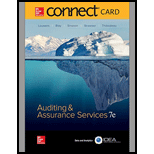
a)
Explain the manner that Person W will establish each of given parameters.
a)
Explanation of Solution
Explain the manner that Person W will establish each of given parameters:
- Person W would draw recorded balance of
accounts receivable from Incorporation R’s year-end workingtrial balance . - Person W would decide the quantity of client accounts by alluding to a rundown of accounts receivable or Incorporation R’s subsidiary accounts receivable.
- Person W would build up the risk of incorrect acceptance depended on earlier evaluations of audit risk, risk of material misstatement, and analytical procedure risk.
- Person W would build up the risk of incorrect rejection depended on his gauge of the cost of expanding his sample (as this cost rises, he would evaluate the risk of incorrect rejection at smaller levels).
- Person W would decide the tolerable misstatement dependeed on the recorded balance of the accounts receivable just as key financial statement subtotals, for example, sales, net income, and total assets.
- Person W would put together the normal misstatement with respect to earlier audits (for repeating commitment) or a pilot sample (for first-year commitment).
- Person W would base the standard deviation of the mean audited values on earlier audits (for repeating commitment) or a pilot sample (for first-year commitment).
b)
Compute the appropriate samples size for the given situation.
b)
Explanation of Solution
Classical variable sampling: It is a sampling method in which each record is considered as a sampling unit. Therefore, each record has an equal chance of being selected as the sample.
Where:
“n” is Sample size.
“N” is Population size (number of transactions)
“R(IR)” is Confidence factor for the risk of incorrect rejection
“R(IA)” is Confidence factor for the risk of incorrect acceptance
“SD” is Standard deviation
“TM” is Tolerable misstatement
“EM” is Expected misstatement
Compute the appropriate sample size:
Given information: N is 2,000; R (IR) is 1.28; R (IA) is 1.65; SD is $52; TM is $50,000; and EM is $10,000.
Therefore, appropriate sample size is 59 accounts.
c)
Explain the way increase in the risk of incorrect acceptance affects the sample size in the given situation.
c)
Explanation of Solution
Compute the appropriate sample size:
Given information: N is 2,000; R (IR) is 1.28; R (IA) is 1.28; SD is $52; TM is $50,000; and EM is $10,000.
Therefore, appropriate sample size is 45 accounts.
As compared to the sample size in sup-part (a), it is decreased to 45 accounts from 59 accounts. This indicates the inverse relationship between the risk of incorrect acceptance and the sample size.
d)
Compute a precision interval for Incorporation R’s accounts receivable.
d)
Explanation of Solution
Precision interval: It is an interval of sample assessments that pedals the audit team’s contact to the risk of incorrect acceptance and risk of incorrect rejection
It is calculated by using following formula:
Precision is calculated as follows:
Compute the precision interval:
Given information: Audited value is $760,000 (working note 1)
Precision is $21,481(working note 2)
Therefore, precision interval is $738,519 to $781,481.
Working note 1: Compute the audited value:
Working note 2: Compute the precision:
Given information: N is 2,000; R (IA) is 1.65; SD is $50; and n is 59.
e)
Present Person W’s conclusion regarding Incorporation R’s accounts receivable using calculation in sup-part (d).
e)
Explanation of Solution
As the maximum variance between the documented balance of $800,000 and the utmost limit from the precision interval ($738,519) is greater than the tolerable misstatement of $50,000, Person W would conclude that the account was materially misstated.
f)
Compute a precision interval for Incorporation R’s accounts receivable. Present Person W’s conclusion regarding Incorporation R’s accounts receivable. Explain the reasons for difference in conclusion in this situation and conclusion in sub-part (e).
f)
Explanation of Solution
Compute the precision interval:
Given information: Audited value is $810,000 (working note 3)
Precision is $21,481(working note 4)
Therefore, precision interval is $788,519 to $831,481.
Working note 3: Compute the audited value:
Working note 4: Compute the precision:
Given information: N is 2,000; R (IA) is 1.65; SD is $50; and n is 59.
As the maximum variance between the documented balance of $800,000 and the utmost limit from the precision interval ($831,481) is lesser than the tolerable misstatement of $50,000, Person W would conclude that the account was properly stated.
The above conclusion would vary from that in sub-part (d) and (e) as the mean audited value ($405) was nearer to the audited value oblique by Incorporation R’s accounts receivable of $400
Want to see more full solutions like this?
Chapter G Solutions
Connect Access Card for Auditing & Assurance Services

 AccountingAccountingISBN:9781337272094Author:WARREN, Carl S., Reeve, James M., Duchac, Jonathan E.Publisher:Cengage Learning,
AccountingAccountingISBN:9781337272094Author:WARREN, Carl S., Reeve, James M., Duchac, Jonathan E.Publisher:Cengage Learning, Accounting Information SystemsAccountingISBN:9781337619202Author:Hall, James A.Publisher:Cengage Learning,
Accounting Information SystemsAccountingISBN:9781337619202Author:Hall, James A.Publisher:Cengage Learning, Horngren's Cost Accounting: A Managerial Emphasis...AccountingISBN:9780134475585Author:Srikant M. Datar, Madhav V. RajanPublisher:PEARSON
Horngren's Cost Accounting: A Managerial Emphasis...AccountingISBN:9780134475585Author:Srikant M. Datar, Madhav V. RajanPublisher:PEARSON Intermediate AccountingAccountingISBN:9781259722660Author:J. David Spiceland, Mark W. Nelson, Wayne M ThomasPublisher:McGraw-Hill Education
Intermediate AccountingAccountingISBN:9781259722660Author:J. David Spiceland, Mark W. Nelson, Wayne M ThomasPublisher:McGraw-Hill Education Financial and Managerial AccountingAccountingISBN:9781259726705Author:John J Wild, Ken W. Shaw, Barbara Chiappetta Fundamental Accounting PrinciplesPublisher:McGraw-Hill Education
Financial and Managerial AccountingAccountingISBN:9781259726705Author:John J Wild, Ken W. Shaw, Barbara Chiappetta Fundamental Accounting PrinciplesPublisher:McGraw-Hill Education





